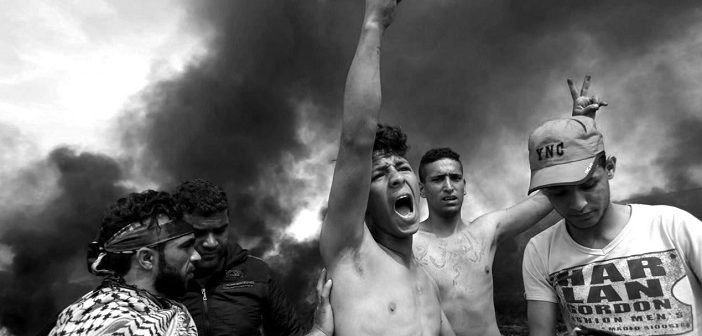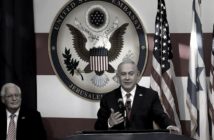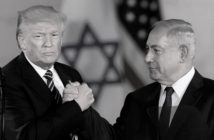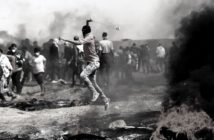In March 2018, Hamas announced that it would attempt to use mass protests to break through the border separating Israel from the Gaza Strip.
Over eight weeks tens of thousands protested at five points along the border every Friday. With a mix of violent rioting and peaceful protest, Israel confronted a complex situation. In clashes over the eight weeks, culminating on May 14, more than 100 Palestinians were killed. Thousands were injured, many of them by live fire from Israeli forces. The clashes have led to condemnation of Israel and questions about Israel’s conduct.
Hamas saw the mass protests as a way to regain legitimacy.
* * *
The Great Return March was planned to begin on Land Day and end on Nakba Day, two annual events that have special meaning for Palestinians. Nakba Day commemorates the 1948 creation of Israel that Palestinians view as a catastrophe. Land Day first took place in 1976 when Arabs in Israel protested against land confiscation. As such the two days lend themselves to mass popular protest and every year they tend to include clashes with Israel’s security forces or high levels of tensions.
Hamas sought to exploit these days for its own ends. After winning Palestinian legislative elections in January 2006 it has been isolated in Gaza and cut off from the Palestinian Authority in the West Bank. This is because it is viewed as a terrorist organization by the United States and other western countries and because it sought to enforce its rule in Gaza over its rivals in Fatah using violence in 2006. It murdered Fatah activists by throwing them off buildings, formed its own security forces and took over Gaza. It also fired thousands of rockets at Israel after Israel’s withdrawal from the Gaza Strip in 2005. Israel subjected Gaza to a blockade and Israel and Hamas fought wars in 2009, 2012 and 2014. Hamas attempted various methods, including tunnels and developing long range rockets, to fight Israel. But by 2018 it’s attempts had failed and it found itself losing legitimacy. The “Great Return March” was conceived as a way to put itself back on the map.
Israel has built a variety of security measures along the Gaza border over the years. Although some in the international community still consider Israel the “occupying power” in Gaza, Israel views itself as having “disengaged” from the Gaza Strip and it views the border around it as a border. Israel also views Hamas as a terrorist organization, so anyone crossing from Gaza is assumed to be a threat. Over the years Hamas has attempted many attacks using various methods from Gaza, and Israel takes no chances with those who approach the border. Egypt has also kept its crossing into Gaza at Rafah closed for the last several years.
In the lead up to the Great Return March Israel’s Defense Minister and authorities warned the potential protesters that they were endangering their lives by approaching the fence. The Israel Defense Forces (IDF) deployed at least 100 snipers along the border and used selective live fire against any protesters who damaged or approached the fence. IDF Spokesman Lt. Col. Jonathan Conricus tweeted on April 27 that “this is terror, just makes. The IDF will continue to defend our people and border.”
Over eight weeks, every Friday, Palestinians sought to breach the fence that runs around Gaza. At five points they gathered in the thousands, usually bringing families along to sit in tents that had been constructed. Hamas activists came and Hamas leader to encourage the faithful. There were also teams of young men, specially prepared to run towards the fence with tools to cut through it. Testimony from witnesses provide a good picture of the various layers of the protest. I also went down to the border with Gaza to see how it transpired in early April.
The IDF positioned snipers along a berm behind the fence. In front of the fence, in Gaza, there was another layer of barbed wire. For most Palestinians the protests consisted of standing a hundred meters or more away from the fence and watching to chanting. Some brought flags and men came to sellfood. Usually the protests began around 10 in the morning and reached a peak after Friday prayers, with a crescendo of more violence protest in the afternoon.
Israel’s policy throughout was relatively consistent. Any demonstrators who reached the fence were often shot. They were targeted in their legs with non-lethal wounds. The overall number of injured points to this consistency. On March 30th, for instance, 19 Palestinians were killed and 1,416 wounded. 758 of those were hit by live fire, according to the Hamas controlled health ministry in Gaza. In subsequent weeks the numbers declined. Israel became slightly more hesitant to use live fire and the activists more hesitant to approach the fence. During the weeks of April there were several controversies involving the allegation Israel shot journalists and health workers. Attempts to fully investigate those instances did not produce a final conclusion. The case of Yaser Murtaja, a Palestinian journalist who had worked with western journalists prior to his death, was emblematic. Israel accused him of flying a drone near the front and being a member of Hamas. But his friends said none of the allegations were true and that he had actually been attacked by Hamas in the past. Like many things in the conflict, the final truth may not be known and there is no unbiased investigation to determine all the facts.
In April the Israel High Court of Justice heard a petition brought by human rights groups against the use of live fire on the border. The court did not make a determination about the rules of engagement and waited until after the mass protests ended in May to do so. When it did rule, on May 23, it found that the IDF use of live fire was acceptable but it warned that it might review this issue and that individual cases of use of live fire might need to be fully investigated. The court was also hamstrung by the fact that there is classified information and national security issues that were not raised publicly at the hearing.
The 14 of May demonstrations, unlike the previous protests came on an auspicious day for Israel. The US was opening an embassy in Jerusalem and Hamas wanted to make sure that the attention and spotlight remained in Gaza. The demonstrations that day were more serious and Palestinians made numerous attempts to breach the fence. Israel also engaged in live fire exchanges with Hamas and brought up tanks to target Hamas observation points along the line. By the end of the day 58 Palestinians had been killed and 2,771 wounded. This was a serious escalation and brought widespread and increasing condemnation internationally.
Israel’s view on the protests has been consistent throughout and it doesn’t see the May 14 events are particularly unique. It views the protests as an attempt to breach its security fence, storm the border and inflict casualties on Israeli civilians who live next to the border. It argues that the protest aspect of the event is a smokescreen for a larger, more deadly, motive. It also argues that the entire event is scripted by Hamas. Israel’s authorities point to videos in which Hamas members have taken credit for the “martyrs” at the border and have passed around photos of the dead young men in Hamas fatigues. For instance Israel claims that 50 of those killed on May 14 were Hamas activists.
The protests in Gaza used numerous methods to breach the fence. They not only brought wire cutters with them, but stored masses of tires to burn to screen their movements. They also innovated by bringing kites and flying kites with burning material over the fence, eventually burning hundreds of acres on the Israeli side. Once the protests were over in mid-May, Hamas continued its assault on Israel. Machine gun fire on May 28 damaged a house in Sderot. Mortars fired on May 29 targeted Israeli communities. And teams of activists from Gaza continued to try to penetrate the fence. 300 burning kites were sent over the border to lay waste fields and nature reserves inside Israel.
The overall picture presented by the Great Return March is that Hamas sought a new attempt to regain relevance after twelve years of disastrous rule in the Gaza Strip. Hamas rules over 1.9 million Palestinians who have no choice over who governs them. Hamas has systematically undermined not only the rights of Gazans but also the infrastructure in Gaza. It sought over the years some kind of reconciliation agreement with the Palestinian Authority but it also sought again and again to find a way to attack Israel. It built a missile program that eventually could reach deep into Israel. Israel built an “Iron Dome” defense system to stop the missile threat. After thousands of missiles fired between 2005 and 2014, Hamas realized the missiles were a failure. Hamas trained frogmen to swim ashore in Israel. They were caught and killed. Hamas build dozens of tunnels reaching into Israel from Gaza. From 2014 to 2018 Israel innovated ways to find and destroy the tunnels. The mass Gaza protests in 2018 were therefore part of the Hamas toolbox of efforts to do something to make itself seem relevant.
Hamas has always been solely a far-right religious movement that encourages violence and terror. It portrays itself as having a political dimension, but its rallies are full of kids and teens dressed in fatigues with missiles and rifles, and theater productions dedicated to showing off its “prowess” in fighting Israel. It boasts of reconquering Jerusalem and liberating all of historic Palestine. Its founding charter is full of anti-Semitism with allegations that Jews, communists and freemasons are nefarious and control the world. It bases these founding documents on 19th century anti-Semitic canards and blend them with religious hatred of Jews. In the view of article 17 of its charter it claimed “Zionist organizations under various names and shapes, such as Freemasons, Rotary Clubs are nothing more than cells of subversion.” This is the far-right conspiracy-laden worldview of Hamas. It presents a janus face, at one point “moderating” and electing more extreme elements such as Yahya Sinwar in February 2017 to leadership positions.
For Hamas the real problem is regional. In 2005 it thought it was riding a wave of victory. It got support from Iran and the Gulf. It had support in Turkey as well from the government. When Muslim Brotherhood leader Mohammed Morsi was elected in Egypt in 2012 it thought it would finally succeed. But Morsi was overthrown, Gulf funding began to dry up and Iran had its own issues at home to deal with. The Syrian Civil War also impacted its relationships in Damascus. Under Abdel Fatah al-Sisi’s rule in Egypt the tunnels Hamas used to smuggle goods from Sinai have been flooded.
It’s ability to construct missiles has been degraded. Iranian know-how and support what once flowed clandestinely through Sudan and then Egypt, has stopped. The weapons flow from Libya’s conflict also dried up. Even Qatar seems to tire of Hamas. Only Turkey and Iran remain and both are so far away they cannot do much for the organization. Turkey’s interest is in seeing Hamas reconcile with the Palestinian Authority. In March Palestinian Prime Minister Rami Hamdallah and Chief of intelligence Majed Faraj were targeted in Gaza by a bomb, bringing to a halt any thought of reconciliation. Hamas planned the Great March of Return once that happened.
* * *
Given that Hamas is so isolated and has lost so many rounds with Israel, it must wonder what is the next step.
Gaza’s 1.9 million people need a future that doesn’t involve isolation, blockade… and Hamas rule.
How can the international community, Israel and the Palestinian leadership help usher Hamas off the stage and provide Gaza with the freedom and hope that it needs?






3 Comments
There would not be any “Hamas problem” if Israel had accepted the democratic rules of elections and not arrested elected MPs as soon as they were elected. The so called “first (ethno-religious) democracy” in the Middle East did not accept the birth of a “second (citizen’s) democracy” in the Middle East. Israel cannot morally condemn Hamas for having doing in the past things Irgun, Stern, Haganah did and Mossad or Israeli Army is doing up till now in a much more “industrial” and systematic way. Manifestations in Ghaza are supported by all local Palestinian groups, from Fatah up to Islamic Jihad, from Hamas up to PFLP because no Palestinian party would have any authority among masses giving up their UN approved right of return to their lands and their Fatherland stolen in 1947/48 and 1967. Of course, the right to return means at the very end either the formation of a bi-national common State or a common secularised State in the land of Israel-Palestine but that’s the rule of democracy. Ethnocracy is not democracy and Hamas like any other political party will have to accept the fact that political principles having their roots in islam have to democratically compete with political principles coming from liberalism, communism, christianity, judaism, etc. The same for Zionist religious or secularised parties. This did happen in South Africa for example, the “land only for the Whites” becoming a common “sunshine land”. …For the moment, Christians of Ghaza do exist under Hamas and manifest at the “fence” with their Hamas and non Hamas muslim compatriots. Manifestations against “Nakba” also take place in the West Bank and within the 1948 green line. Up till now, Israeli civilians and militaries have no casualties contrary to Ghaza civilians but policy carried on by Tel Aviv authorities are creating conditions for a new war in which a lot of Israel subjects could be killed with the danger of defeat at the very end. Is this the real interest of the people living within the wall built by Sharon and Netanyahu ? History tells us that no wall can last eternally. There are no reason why an exception to this rule could take place in the Holy land that gave birth to the common monotheistic based culture in three forms …and even more, if we include secularised political ideologies having at least partly their root in the judeo-christo-islamic trend.
Seth J. FRANTZMAN, thanks! And thanks for sharing your great posts every week!
Les gazaouis vivent à l’identique des juifs de Varsovie (1940-1943) dans un ghetto dont les geôliers est l’armée israélienne. Comme les juifs sous le joug des nazis ils sont privés de la liberté de circuler, de commercer, vivent sous le seuil de pauvreté et endurent terreur et oppression.
Combien de morts, combien d’années encore pour mettre en oeuvre une solution ” acceptable” qui mettrait fin à une situation indigne de l’être humain ?
Honte à tous ces politiques palestiniens et israéliens qui n’ont cherché que la violence pour asseoir leur autorité, toujours au nom de dieu mais jamais au nom de l’humanité.